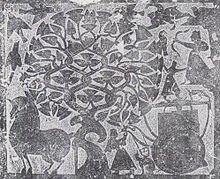Fusang
Fusang (Hanzi: 扶桑; Pinyin: Fú Sāng) merujuk kepada beberapa entitas berbeda dalam sastra Tiongkok kuno, sering kali pohon mitologi atau wilayah misterius di kawasan Timur.

Dalam Klasik apa iya Kelautan dan beberapa teks kontemporer,[1] istilah tersebut merujuk kepada mitologi pohon kehidupan, yang secara alternatif diidentifikasikan sebagai mulberry atau hibiscus, yang diduga tumbuh di timur Tiongkok, dan mungkin berbagai kawasan di timur daratan.[1][2]
Referensi sunting
Catatan sunting
- ^ a b Kesalahan pengutipan: Tag
<ref>tidak sah; tidak ditemukan teks untuk ref bernamaNeedham43 - ^ Joseph Needham (1976). "Part 3, Spagyrical discovery and invention : historical survey, from cinnabar elixirs to synthetic insulin". Science and civilisation in China. 5 : Chemistry and chemical technology. Cambridge University Press. hlm. 19. ISBN 978-0-521-21028-7.
- Leylamd, Charles Godfrey (1875) Fusang; Or, The Discovery of America by Chinese Buddhist Priests in the Fifth Century, New York: Barnes & Noble, 1973. Reprint: Forgotten Books (2010), ISBN 978-1-4400-7044-0.
- Vining, Edward P. (1885) Inglorious Columbus; or, Evidence that Hwui Shan and a Party of Buddhist Monks from Afghanistan Discovered America in the Fifth Century, A.D.. New York: D. Appleton and Company, ISBN 978-0-217-68056-1
- Williams, S. Wells (1881): Notices of Fu-sang, and Other Countries Lying East of China, in the Pacific Ocean. Translated from the Antiquarian Researches of Ma Twan-Lin, with Notes. Tuttle, Morehouse & Taylor, New Haven. Downloaded from https://archive.org/details/noticesoffusanga00willrich on 5 June 2011.
Pranala luar sunting
- www.uh.edu/ Diarsipkan 2023-05-31 di Wayback Machine.
- Description of Fusang in ancient Chinese literature 《梁書•五十四•列傳四十八》 (Tionghoa)
- Article at CRIENGLISH.com on Xu Fu's expedition to Japan
- Stan Steiner (1979). Fusang: The Chinese Who Built America. Diarsipkan dari versi asli tanggal 2015-10-21. Diakses tanggal 2018-05-12.
- Charles Godfrey Leland (1875). Fusang: The Discovery of America by Chinese Buddhist Monks in the Fifth Century. Also full view at Google Books.
- A full translation in French of the account in the Book of Liang was given by Schlegel (1892) JSTOR 4524934